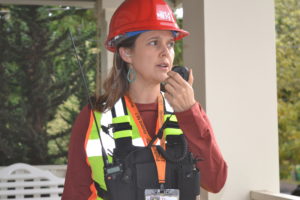Operating Your Radio
When the Big One hits, you don’t want to be fumbling with your radio and trying to read a list of frequencies. You’ll want to turn your radio on and have immediate access to the frequencies that will be used by other AROs in your area. And you don’t want to be terrified of talking if you have important messages to convey. But the two biggest hurdles for new Amateur Radio Operators (AROs) are:
- Understanding how to program their handhelds, either manually or with CHIRP software
- Having the confidence to get on the air, knowing when to talk and when not to talk
 But we’re lucky to have some great training and practice opportunities within the NET Program, as well as outside the program. It can seem intimidating at first, but once you get past these first two hurdles, you’ll be amazed at how quickly you will become comfortable operating your radio.
But we’re lucky to have some great training and practice opportunities within the NET Program, as well as outside the program. It can seem intimidating at first, but once you get past these first two hurdles, you’ll be amazed at how quickly you will become comfortable operating your radio.
Programming & Operations Classes
The Piedmont NET pioneered classes for passing the FCC exams and for continuing education for NET AROs. Portland NET amateur radio operators have been carrying on this tradition. Classes and exam opportunities are held four times a years. The continuing education workshops are usually offered several weeks later — to help new hams learn how to program their radios, pass messages, participate in a directed radio net, handle the challenges of simplex communications, and acquire a host of other operating skills. For those unfamiliar with these terms, a brief description follows. For information about the classes and how to register, visit the Ham Radio page on this site.
Programming — The channels or frequencies used by the NET Program and most other agencies are fixed. Radios have memories and the channels you use can be stored in those memory locations. That way, all you have to do is dial up a particular channel on your radio and begin talking, rather than having to remember and input the frequency. Putting this information into memory so that it can be retrieved later is call programming the radio.
When you use repeaters to communicate long distances with handheld radios (handheld transceivers or HTs), your radio must transmit on a frequency other than the one it receives on. This is referred to as the repeater’s offset. Moreover, repeaters often use particular codes or tones that admit only signals that carry the tone to access the repeater. This is the CTCSS tone or DCS code, although repeaters in Portland typically use the former. When using a repeater, consequently, the offset and tone are also programmed into the radio’s channel dedicated for the use of the repeater.
Message Handling — As you will learn, there are many different formats for passing messages. These run all the way from very structured, formal, and efficient formats to more casual forms that field operators without much training can use. A few simple skills, however, can make your message-passing much more efficient and reliable.
Directed Radio Nets and Net Control — Most of the time, you will be participating is radio conversations where one station, called a net control, is acting as the traffic cop, keeping all the communications flowing smoothly. We call these directed nets. Because radio operators cannot hear each other when they transmit, there is much greater need for this coordination than would be required for a phone conversation, where people can interrupt each other. Moreover, some stations may not hear other stations and inadvertently interfere with communication. These are both reasons why it is important to know how to use and behave during a directed net.
Simplex Communication — It is a “simple” idea: direct radio-to-radio communication without benefit of a repeater. You may have already some experience using FRS or CB radios. Because of the frequencies and low power levels we use, however, it can be among the most challenging radio communication you will encounter. Our operating frequencies favor “line-of-sight” communication. Obstacles like hills and buildings interfere with signal propagation, and many stations in Portland will not be able to hear one another, without some operating protocol to help organize the communications. Fortunately, we have developed monthly NET Simplex Exercises, which you will help you learn and practice, especially as a certified NET ARO.
ARO Certification — It used to be the case that any amateur radio operator could wear a NET ARO badge. That is no longer the case. Years ago, we discovered that many hams, and in particular new hams, lacked to the operating skills to participate effectively in NET radio exercises and events. Since 2016, the Portland NET program has required that NET AROs complete a certification workshop. The task list for certification is posted on the PBEM web site, as is a description of how to find your Radio Training Liaison (RTL). Portland has five RTLs, and they will guide you to a workshop and answer any questions about the ARO certification program you may have.
